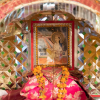Eminent theatre personality Veenapani Chawla (1947‒2014) established Adishakti in Mumbai in 1981, in a quest to evolve a unique theatre language. Later, she shifted Adishakti to Puducherry, where it finally settled into its own campus in 1981. The theatre that Chawla wanted to mould and explore was ground-breaking in the field of modern Indian theatre. Distancing itself from the Eurocentric practices followed by contemporary theatre groups, Adishakti charted its own course, by employing elements from traditional Indian art forms like dhrupad singing, kalaripayattu, chhau, vedic chanting, gusti, etc., and bringing together diverse cultures, languages and movements. Rooted firmly in plural aesthetics and in re-interpreting popular myths, Adishakti has broken away from the limitations of Indianness and has evolved a new performance language of its own. In this video, the artistes at Adishakti speak about the methodology that they employ in their productions.
Theatre Space of Adishakti: Practices and Techniques
in Video
Published on:
Shrinjita Biswas
Shrinjita Biswas is a writer and a researcher based in New Delhi. She has been engaged as a script writer and experiments with the mediums of sound and photography. Her audio documentary ‘My Sister in a Dystopian World’ is part of the 15th Asian Women’s Film Festival (IAWRT) and is travelling across the country. She is currently a researcher with the Alkazi Foundation for the Arts.












